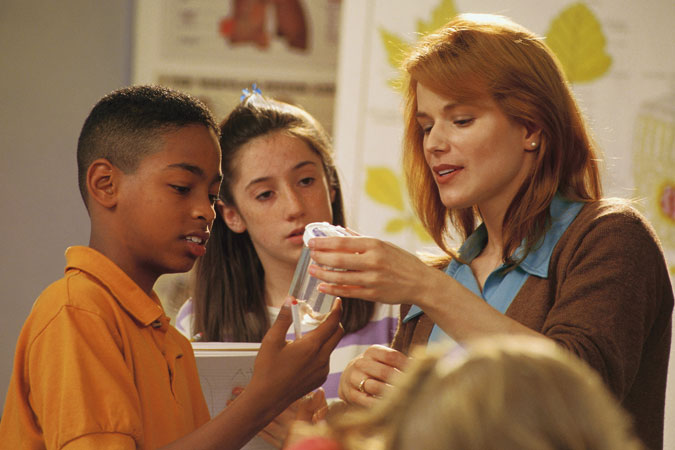
By now we’re all settling into our routines for the year and getting to know our students. Inspired by St. Ignatius of Loyola, who advised “meeting them where they are” as the starting point for conversation, I’m wondering, do we meet them where they are? In order to take this Ignatian approach, we need to get to know them. Beyond playing a few get-to-know-you name games, which have their place, how do we go deeper and learn who these young disciples-in-training before us are?
1. Ask them!
The most obvious way to get to know another person is to ask that person questions and engage in conversation. Certainly first-day-of-the-year sessions include some icebreakers, which are a good starting point. But they can’t be the ending point. I like to start sessions with questions that lay a foundation for the lesson by revealing something about what the students already know or think. For instance, a lesson on celebrating the Mass might start with a survey of how the group celebrates special occasions, giving them a chance to talk about their happy experiences of family Thanksgiving or Christmas.
2. Interact with them.
In my parish, the young people come directly to the classroom as they arrive. This means that I have at least a few minutes to chat informally with the early birds before the bell rings. While I like to provide some sort of gathering activity or question to consider each week, these are often the types of activities we can talk while completing or pondering. I talk to students about a history test they had mentioned last time or a basketball game or school concert coming up in the calendar. These brief conversations are starting points for learning more about the people in my charge.
3. Allow interruptions.
I’m not advocating allowing classes to spin out of control and into irrelevance, but we do need to be sensitive to where the young people are. Perhaps they need to process some current event with deeper discussion, and so we postpone the planned lesson to talk about the Christian response. But even the smaller interruptions can have their value. We are not machines as catechists. If we are to live as the missionary disciples we’re called to be, part of that is listening to the young people. If they make a few random comments, acknowledge them as appropriate and move on with the session. I’ve been known to let a few topical side trips occur and then wrap them up with a, “Now we’ve strayed from topic and need to get back to business.” It’s a human response, and engaging in human interactions is the point.
4. Respect them.
My classroom only has one rule: Respect. The driving idea is that I don’t want to bog us down in rules. Kids know how to behave, and I acknowledge that to them. But just as I ask the young people to respect God, all adults in the program, one another, and our learning space, I need to respect the young people in turn. I pray for patience when necessary and will discipline students when needed, but I try not to dwell on the disruptive acts. I make mistakes; the young people make mistakes; but respect allows us to move forward.
As we get to know the young people in our groups, we can better meet them where they are. That may include playing Christian music in the genre they like, using extra sports examples, or inviting students to use their drama or art skills in activities. Once we meet the young people where they are, we will better understand them as individuals and can lead them to Christ, which is our goal.
Our books are wonderful tools, but we make the faith come alive when we note the relevance and context in which we’re teaching. That varies from parish to parish and even from classroom to classroom, but when we make the effort to meet the kids we serve, we are doing our duty as catechists and living as disciples.
How do you meet young people where they are?





Wonderful insight! I love to find out that I don’t have to have a perfect class environment. Having a mix of 4th and 5th grade special needs disciples it’s hard to keep them quiet or their attention for more than a few minutes at a time. I always welcome their input and try to incorporate current events to keep them engaged. We often go off course but somehow come back to the topic. Great to know we’re not doing ok. ?
I meant it’s great to know that we’re doing ok! ?
Diana, I’m glad the article encouraged you! None of us is perfect, and so we can’t expect a perfect class environment. We are called to do our best and trust the Holy Spirit to do the rest. Thank you for sharing your thoughts.
Your advice is good. This will be my 47th year as a Catechist, most of which are working with middle schoolers, for the past 28 years 8th grade and Confirmation prep. My problem is time. I have my students for one hour and 15 minutes a week, and my task is to thoroughly review the basic teachings of the church, introducing few new topics. I have little time to engage in ice breaking activities. Indeed, my students knew each other better than I know them, they having been in the program for 7 years, and most attend the same middle school. I have broken my year down placing a greater emphasis on moral decision making and social justice than Sacraments, Beliefs, and Prayer. Why? Because 1) their previous catechists have done a most excellent job with Sacraments, Beliefs, and Prayer, and 2) they have no clue what the Catholic Social Justice teachings are and are quite shocked that the Catholic Church teaches them. Although they can list the Ten Commandments, they seem to have no clue as to how to make a good moral decision. Although they know what sin is and can tell you how to avoid sin, if a particular action is not “on the list,” they have a hard time ascertaining it’s sinfulness. When it comes to prayer I try to introduce and incorporate Lectio Divina into their prayer life, for they know how to pray the Rosary and the Chaplet. Their former catechists have done an excellent job. If I have a problem it is with my DRE who a times thinks of my students a children to be entertained (Movie night—a cartoon about a saint) or a work force (a class given over to clean the parking lot or a building to be decorated) or helpers ( the 1st graders are doing an art project and the 8th graders are called from class to help). I get frustrated.
I meet young people where they are by listening to them and the challenging them to think outside of the box.
A good strategy. Patricia!